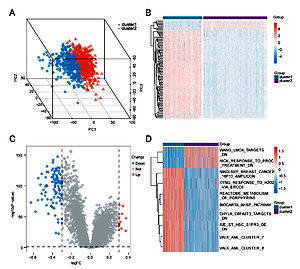Current issue
Archive
Manuscripts accepted
About the Journal
Editorial office
Editorial board
Section Editors
Abstracting and indexing
Subscription
Contact
Ethical standards and procedures
Most read articles
Instructions for authors
Article Processing Charge (APC)
Regulations of paying article processing charge (APC)
INFECTIOUS DISEASES / RESEARCH PAPER
The role of the ferroptosis-related gene in the immune activity and prognosis of sepsis
1
Department of Intensive Care Unit, The First Affiliated Hospital of Nanchang University, Dong Lake District, Nanchang, Jiangxi Province, China
2
Medical Innovation Center, The First Affiliated Hospital of Nanchang University, Nanchang, Jiangxi Province, China
3
Graduate School, Chinese Academy of Medical Sciences and Peking Union Medical College, Beijing, China
4
Department of General Surgery, Peking Union Medical College Hospital, Beijing, China
5
Department of Key Laboratory, Shanghai Pudong New area People’s Hospital, Shanghai, China
Submission date: 2021-11-23
Final revision date: 2021-12-14
Acceptance date: 2022-01-01
Online publication date: 2022-01-02
Corresponding author
Kejian Qian
Department of Intensive Care Unit, The First Affiliated Hospital of Nanchang University, Medical Innovation Center, 17 Yongwaizheng St, Dong Lake District, Nanchang 330000, Jiangxi Province, China
Department of Intensive Care Unit, The First Affiliated Hospital of Nanchang University, Medical Innovation Center, 17 Yongwaizheng St, Dong Lake District, Nanchang 330000, Jiangxi Province, China
KEYWORDS
TOPICS
ABSTRACT
Introduction:
Sepsis is a leading cause of mortality in intensive care units worldwide. Ferroptosis, a form of regulated cell death dependent on iron, has been proven to be altered during sepsis, including increased iron transport and uptake into cells and decreased iron export. A better understanding of the role of ferroptosis in sepsis should expedite the identification of biomarkers for prognostic evaluation and therapeutic interventions.
Material and methods:
We used the mRNA expression profiles of sepsis patients from Gene Expression Omnibus (GEO) to analyze the expression level of ferroptosis-related genes and construct molecular subtypes.
Results:
Two distinct ferroptosis patterns were determined, and the overall survival of the two clusters was highly significantly different. Gene comparison analysis was performed on these two groups, and there were a total of 106 differentially expressed genes (DEGs). Pathway enrichment analysis of these genes showed that ferroptosis and immune-related pathways were enriched, suggesting that immune pathways might be critically involved in sepsis. To systematically predict the prognosis of sepsis, we constructed a nomogram model; the calibration plot nomogram showed excellent concordance for the 7-, 14-, and 28-day predicted and actual overall survival probabilities. Finally, the results of bioinformatics analysis were validated in animal and cell models.
Conclusions:
In this study, we construct a ferroptosis-related nomogram that can be used for prognostic prediction in sepsis. In addition, we revealed that ferroptosis played a non-negligible role in immune cell infiltration and guiding more effective immunotherapy strategies.
Sepsis is a leading cause of mortality in intensive care units worldwide. Ferroptosis, a form of regulated cell death dependent on iron, has been proven to be altered during sepsis, including increased iron transport and uptake into cells and decreased iron export. A better understanding of the role of ferroptosis in sepsis should expedite the identification of biomarkers for prognostic evaluation and therapeutic interventions.
Material and methods:
We used the mRNA expression profiles of sepsis patients from Gene Expression Omnibus (GEO) to analyze the expression level of ferroptosis-related genes and construct molecular subtypes.
Results:
Two distinct ferroptosis patterns were determined, and the overall survival of the two clusters was highly significantly different. Gene comparison analysis was performed on these two groups, and there were a total of 106 differentially expressed genes (DEGs). Pathway enrichment analysis of these genes showed that ferroptosis and immune-related pathways were enriched, suggesting that immune pathways might be critically involved in sepsis. To systematically predict the prognosis of sepsis, we constructed a nomogram model; the calibration plot nomogram showed excellent concordance for the 7-, 14-, and 28-day predicted and actual overall survival probabilities. Finally, the results of bioinformatics analysis were validated in animal and cell models.
Conclusions:
In this study, we construct a ferroptosis-related nomogram that can be used for prognostic prediction in sepsis. In addition, we revealed that ferroptosis played a non-negligible role in immune cell infiltration and guiding more effective immunotherapy strategies.
Share
RELATED ARTICLE
We process personal data collected when visiting the website. The function of obtaining information about users and their behavior is carried out by voluntarily entered information in forms and saving cookies in end devices. Data, including cookies, are used to provide services, improve the user experience and to analyze the traffic in accordance with the Privacy policy. Data are also collected and processed by Google Analytics tool (more).
You can change cookies settings in your browser. Restricted use of cookies in the browser configuration may affect some functionalities of the website.
You can change cookies settings in your browser. Restricted use of cookies in the browser configuration may affect some functionalities of the website.



